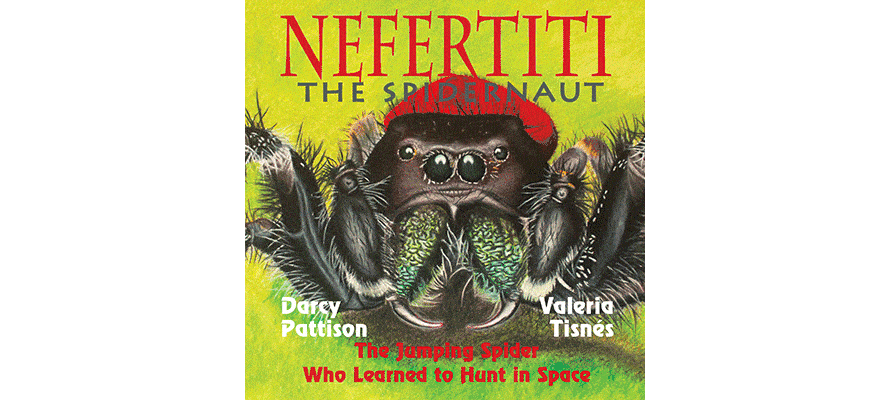Category: Children’s Book
Reviewed by: Marianne Dyson
Title: Nefertiti the Spidernaut: The Jumping Spider Who Learned to Hunt in Space
Author: Darcy Pattison
Illustrator: Valeria Tisnes
Ages: 6 to 8
NSS Amazon link for this book
Format: Paperback/Kindle
Pages: 32
Publisher: Mims House
Date: September 2016
Retail Price: $3.99 Kindle
ISBN: 978-1629440613
Nefertiti, the Spidernaut is the true story of a jumping spider sent to the International Space Station in 2012. The experiment, proposed by 18-year-old Amr Mohamed of Egypt, was sponsored by YouTube and Lenovo and conducted in collaboration with Space Adventures, NASA, and the European and Japanese space agencies.
Jumping spiders do not use their webs to capture prey like most spiders. The Johnson jumping spider leaps onto its prey and crushes it with its front mini-legs. It then injects an acid that allows it to drink its food. The question posed by the experiment was whether or not a jumping spider would be able to catch its food in space, and thus be able to survive.
The story is told in mostly chronological order with the birth of the spider, its selection and preparations, its time in space, and its return to Earth. The reasons for the various prelaunch tests are not explained in the primary text. Thus the children may wonder: Why is the spider subjected to a week of darkness when the habitat has light? Why is it starved when fruit flies are to be provided for it to eat? Why is the spider exposed to extreme cold when the space station is comfortable for humans? Not knowing the lifespan of the spider or how long it normally survives without food or water or light, or what temperatures it tolerates, made it hard to appreciate the danger the spider’s life was in during these tests or its time in space. Being in freefall seemed to be the least of its worries!
However, most of the answers are included in the back matter, along with the name of the student researcher who well deserves recognition. Parents or teachers are advised to read the back matter first to prepare to answer the questions that curious children may ask about the spider.
The story is a fascinating one and worth sharing with kids, but the language, art, and technical nature of the topic may make it more appropriate for an older audience than the 6-8 age group.
The sentences are complex and contain words unfamiliar to younger readers such as larvae, pinhead, abdomen, dragline, and anchored. The glossary only includes three words: microgravity, spidernaut, and hypothesis. The author defines others, such as berthing and habitat, using synonyms in the text, but the overall reading level remains high for the picture book audience.
Though the illustrations may be accurate in their depiction of jumping spiders, they certainly aren’t cute. Younger children may even be somewhat repelled by the cover close-up of all those hairy legs! Actual photos of the habitat, people involved, and the spider would have been very helpful.
Nefertiti is the story of a true space pioneer, and her happy ending gives us all hope that we too can adapt to living in space. Parents and teachers looking for examples of animals adapting to new environments and how experiments are conducted in space will find this book quite useful.
© 2016 Marianne Dyson
Please use the NSS Amazon Link for all your book and other purchases. It helps NSS and does not cost you a cent! Bookmark this link for ALL your Amazon shopping!



















